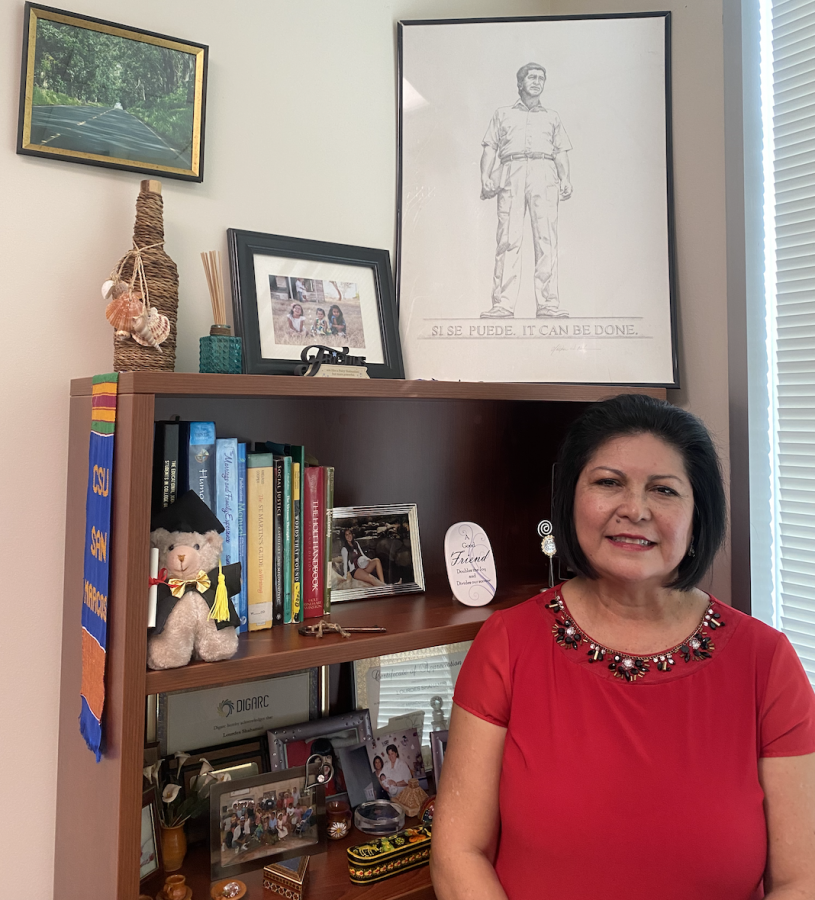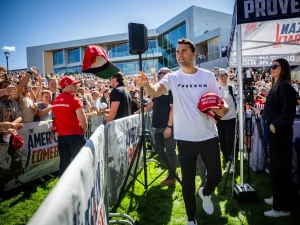CSUSM faculty member reflects on her time at the university
Shahamiri reflects on 30 years of working at CSUSM.
December 7, 2021
Lourdes Shahamiri is the Catalog and Curriculum Coordinator in the Academic Affairs/Academic Programs Department. Shahamiri has held this role since 1991, publishing all CSUSM catalogs.
In addition, some of her contributions include co-organizer of the creation of the Cesar Chavez statue, developed approaches for establishing the Hispanic Serving Institution status and currently serving on the Craven Taskforce. She has been a mentor to many students and a wonderful colleague. Shahamiri is retiring after 30 years of working at CSUSM.
How long have you worked for Cal State San Marcos?
I was hired on Oct. 31, 1991, Halloween day. I have seen the campus grow since I was hired. We were at the facility by the furniture store (Jerome’s). Things were very simple back then. There were only a few buildings.
So, in all the time you have worked for Cal State San Marcos, what have been your responsibilities?
Catalog and curriculum coordinator. I have been in this position since then and I never left.
Do you like your role here?
I love it. It’s fascinating to see all the programs come to fruition. My responsibility is not only analyzing the curriculum but making sure that the new programs are edited and submitted to the Chancellor’s Office after they are passed by the Senate.
It’s fascinating when the students tell me, “we’ve heard that there’s a new program coming on board and to finally see it approved and placed in the catalog.” That has been one of my favorite things to see that their programs get approved.
I think you answered my next question, which was what has been your favorite thing about working for Cal State San Marcos and I guess with the role that has been your favorite thing?
That has been! There’s a second part to the question that is. I’ve had the ability to participate in many initiatives on campus, and that has really enhanced my work. There are several that I can mention to you that really compliment my work.
It was exciting to see initiatives come our way and just having the time you know to participate in them, and to do my work as well, one I can mention is our Cesar Chavez statue, that was one of my favorite initiatives. I saw it develop from ground up and I want to say that it has been said that it was a top down approach to the project and it’s not so this was one of the most transparent projects. He was created from ground up, I know this because I was in the committee that brainstormed about creating a Caesar Chavez statue, and in fact there’s a brief history in the library that details how the statue came about.It was an honor to serve in that committee and to see the statue developing in such a short timeline, this has never happened.
I don’t think other universities’ committees started talking about it, and this was the Hispanic Advisory Council, which used to advise President Stacy back then and I was a part of it. It was April 1996 when we started talking about what we could do on the Cesar Chavez Plaza. The Plaza had already been named and some ideas from our group were perhaps we could do a bench, a fountain or a tile wall. And I came up with the idea of a statue.
The group allowed me the flexibility to run with the project, and that’s how the project began. There’s a lot of detail that I can tell you, but I don’t know how much.
But that was one of my favorite projects because it was such a short time. Imagine from recent promissory from April1996 to his birthday on Mar. 31, 1997, the statue was installed, so it was an honor truly to see that project come to fruition with the family present in the community members. It was so symbolic to house a Chavez statue on campus because it was an opportunity for creating social change.
It’s very symbolic to many students who are struggling to obtain an education. For all his work you know, the way he treated human beings, he gave them their dignity and worked hard for it. I saw it as an opportunity to honor him and his legacy and I’m so glad that I received the support from faculty, students, administration, and community members to finish this project in such a short timeline. It was amazing! So, that was one.
Has there been something that’s not been your favorite thing about working at Cal State San Marcos?
It’s hard for me to think negatively of Cal State San Marcos. It was a little bit difficult how many times I’ve moved during the growth. I’ve moved 13 times, in the span of time that I’ve been here, this is the longest I’ve been in this office. But because our unit was small at the time that they were building, they would move us to a different location so they could finish whatever they were doing and just find space for faculty. Whatever the situation was, we needed to move. I think that it could be one of my least favorite. Sometimes they would ask me to pick up and go during catalog production, so I was like “OK! we have to go, we have to go!” But other than that, it’s been a wonderful experience.
What are your plans for retirement?
Traveling, gardening, cooking and I’m open to whatever the future brings. There are many opportunities in the community to continue to make change, and that’s hopefully what I get to do.
Do you feel like you have left great accomplishments when you leave your position?
Aside from the Chavez statue, yes. The Hispanic Serving Institution status was another initiative that I felt very happy to have been part of. There was an opportunity for me to partner with a community member, Bill Delafuente and he has done many things for our students. We talked and we decided that it was time for us to speak with administration and recommend that the Hispanic Serving Institution initiative move forward and so we did.
We spoke with then President Karen Haynes about the importance of having the Hispanic serving institution designation, and we worked very hard. We developed three phases for accomplishing the status and that was another very important initiative for the campus, so I’m glad that I was part of it.
Any advice for the new person that will be taking the role?
“Enjoy the work as much as I do!” Curriculum is a very precise work, and we need to make sure that whatever we represent in the catalog is accurate and it’s a big job, it takes a lot of time, dedication and commitment. And I enjoyed every bit of it, and I hope that the next person will also feel the same way.
Do you have any regrets? Anything that you wish you would have done differently?
No regrets. I learned a lot over these 30 years. The catalog has been done in so many different formats. Many software packages from designing the catalog that went online was a big change for this office, and I believe it was for the better. It was less work for me in terms of finishing the product and publishing it, and sometimes I asked myself, well it was a lot of work the way we were doing it before and always with the thought in mind for the students. “How would the students view the catalog best?” And then you have to move with technology as well.
So, it was important for our office to move forward and create a better approach for creating the catalog, better design, I guess. Or creating the catalog. So, it’s been a wonderful experience. A lot of work in the past, you know, from collecting photos to going to check the blueprint, travel to having an online and having it in control, it makes better sense.







